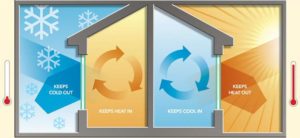YOUR FURNACE
During winter, the furnace is one of the most important components in your home. Since you want to keep your family warm, it is important the furnace runs properly. A properly maintained system will deliver maximum heat output to the home without wasted energy or risk of harmful emissions. The furnace is composed of four main parts: the air filter, blower, heat exchanger and evaporator coil. The heat exchanger is made up of coiled tubes, which contain the hot combustion gases. When the blower turns on, cool air flows over the gas-to-air heat exchanger, the air gets warmer without coming into contact with dangerous gases. The heated air then rises into a sheet-metal box, called the plenum, which is connected to supply ducts and distributed throughout the home. After giving off its heat, the combustion gases get passed through the flue pipe and safely exit the house.
HEAT EXCHANGERS AND COMBUSTION GASES
It is very important to maintenance your furnace yearly. Combustion spillage can happen whenever fuel is burned. Since heat exchangers hold dangerous combustion gases, any cracks, splinters, or holes are extremely dangerous, because it may end up in your living space. With a properly working heat exchanger and ventilation system, none of the combustion gases should ever make it into the circulating air. Unfortunately, combustion leakage can occur and you may not even notice since many combustion gases are odorless and colorless.
HARMFUL SUBSTANCES RELEASED WHEN BURNING FOSSIL FUELS
- Carbon Monoxide
- Carbon Dioxide
- Nitric Oxide
- Nitrogen Dioxide
- Sulfur
- Volatile Organic Compounds
- Hydrocarbons
TOP THREE REASONS WHY COMBUSTION GASES LEAK INTO THE HOME:
- Equipment Failure (cracked heat exchanger)
- Chimney or ventilation problems
- Pressure Problems (negative pressure causes backdrafts)
CRACKED HEAT EXCHANGERS
Typically the main cause of heat exchanger failure is lack of professional maintenance. When dirt and dust accumulate on filters, blowers, coils, and heat exchangers, it becomes more difficult for air to pass through and get heated. If there isn’t enough airflow or if the heat exchanger has developed a layer of dust and dirt, the heat exchanger could possibly overheat and cause cracks or splinters to develop. Excessive gas pressure is another potential cause for heat exchangers to develop cracks.
STAYING SAFE
Its nearly impossible to tell if you have a cracked heat exchanger, unless you are a professional HVAC technician. The best indication of a heat exchanger problem is with a carbon dioxide detector. If the detector continues to go off, don’t ignore it! Turn all fuel-burning appliances off and call your local Service Professionals. Consider scheduling annual furnace maintenance and make sure you are checking your air filter every 30 days and cleaning or replacing it when it gets dirty.
CRAKCED HEAT EXCHANGER?
If you have a cracked heat exchanger, you need to replace it or replace the entire furnace. If you suspect any problems with your furnace or heat exchanger, contact the Service Professionals at Delcor for exceptional service and care!




